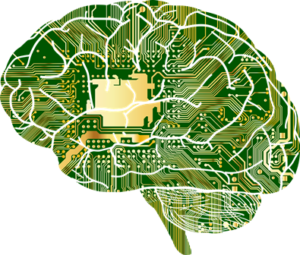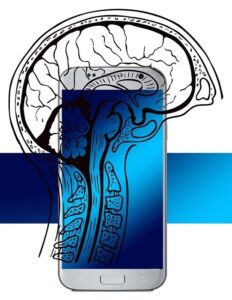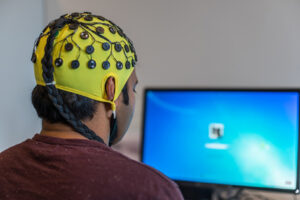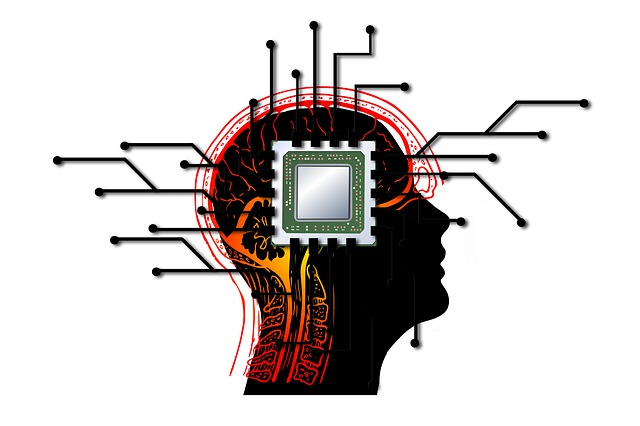A number of trend forecasters assert that emerging innovations in brain-computer interface (BCI) will give rise to a new era of communication and human intelligence. Among these visionaries is co-founder of Singularity University, Peter Diamandis. In presentations, as well as his book The Future Is Faster Than You Think, Diamandis describes today’s disruptive technologies. Technologies that are rapidly converging and enabling a world in which our own neocortex will be one with the cloud, concurrently interconnected with artificial intelligence (AI), with machines, with neurobionic devices, and potentially, with the rest of humanity.

Peter Diamandis – engineer, entrepreneur, author and investor, best known for being founder and chairman of the X Prize Foundation, as well as the co-founder of Singularity University.
Intro To Brain-Computer Interface (BCI)
Brain-computer interface (BCI), also called brain–machine interface (BMI), is a direct communication pathway between the brain and an external device. BCIs can be as intricate as placing devices directly on the brain, or via devices that communicate with computers without the need for invasive surgery.
 Presently, the idea of connecting devices to our neurons is already a reality. Parkinson’s patients, for example, have implants in the brain that replace tissues that have been destroyed by disease. While these were primitive devices at the outset, newer iterations are able to download software wirelessly from outside the patient to the neural implant connected to the brain. Diamandis also points to the example of robotic limbs, used by people who have had a cervical break.
Presently, the idea of connecting devices to our neurons is already a reality. Parkinson’s patients, for example, have implants in the brain that replace tissues that have been destroyed by disease. While these were primitive devices at the outset, newer iterations are able to download software wirelessly from outside the patient to the neural implant connected to the brain. Diamandis also points to the example of robotic limbs, used by people who have had a cervical break.
They can’t move, can’t feel their extremities, can’t speak. But you could bypass all of the normal pathways and go straight to the brain. Go to the homunculus of the sensory or motor cortex of your brain, and be able get sensory information directly in, then be able to think, “I want to control that robotic arm to pick up an apple,” whatever it might be. They expect to do two gigabits per second of connectivity from the neocortex to the cloud. But that’s just the beginning.
Similar applications of BCIs and BMIs can enable someone to move a cursor and type on a screen – without a keyboard. And soon this will evolve and give humans the ability to sense at a distance or manipulate motors controls at a distance, opening a brand new world of business applications – from utilizing robots in industrial settings,, to more delicate operations like remote surgery.
Startups and established companies alike realize the promise of brain-machine interfaces. They are racing to link humans to tech and machines, allowing humans to control digital technology using only their minds. Elon Musk and his team at Neuralink, for example, announced that they plan on having a neural link in humans by the end of 2020. Such brain-machine interfaces will create a new way for humans to interact with technology, whether it be their smartphones, smart speakers, voice assistants, cars, and even each other.
Biological Limit Of Human Brain Evolution
In order to illustrate the significance of brain-computer interface, Peter Diamandis explains the biological limitations of our brain’s evolution. The outer part of the brain responsible for higher-order functions such as sensory perception, cognition, generation of motor commands, spatial reasoning and language – called the neocortex – occupies about 80% of the size of the human brain. And despite the hundred billion neurons and the hundred trillion synaptic connections, we only process a fraction of what comes in. We have limited memory and limited processing power. We could use an “upgrade”, but the fact is, the last evolution to our neocortex happened approximately two million years ago (the time in which we developed our big foreheads). Unfortunately, Diamandis continues, the evolution of our brain was a one-shot deal. We haven’t had one since, because the size of our brain is limited to the size of a woman’s birth canal. If we developed a bigger neocortex, thus a bigger head, this would kill our mothers, which isn’t conducive to our species’ survival. Unless, Diamandis points out, our brain’s evolution is accomplished via technology instead of biology.
Present-Day “Brain Extenders”
 In actual fact, the future of expanding our neocortex via a brain-computer interface, is already here. We’ve already been doing this with the smartphone. A Smartphone is essentially a neural extension of our brains. We are already much more intelligent thanks to the “brain extenders” we carry in our hands, even if they’re not directly connected to our brain. Our brain, though indirectly, can directly talk wirelessly to the cloud. A smartphone, for example, gives a student in Africa access to all of human knowledge. They have more access to information than a student at a prestigious university only 20 years ago. So in a way, we have continued the growth and evolution of the human brain.
In actual fact, the future of expanding our neocortex via a brain-computer interface, is already here. We’ve already been doing this with the smartphone. A Smartphone is essentially a neural extension of our brains. We are already much more intelligent thanks to the “brain extenders” we carry in our hands, even if they’re not directly connected to our brain. Our brain, though indirectly, can directly talk wirelessly to the cloud. A smartphone, for example, gives a student in Africa access to all of human knowledge. They have more access to information than a student at a prestigious university only 20 years ago. So in a way, we have continued the growth and evolution of the human brain.
Synthetic Neocortex In The Cloud
So what’s the next big step in the evolution of brain-computer interface? Peter Diamandis reiterates the premise of his mentor and founding partner at Singularity University, Ray Kurzweil. Kurzweil believes that our neocortex will soon connect wirelessly with the cloud via a high bandwidth brain-computer interface. This will, essentially, give us the ability to add more hierarchy to the neocortex, just like we did two million years ago. We will basically do this again and again. Only this time it will be a synthetic neocortex in the cloud. So we can expect a future in which we will continuously increase and update our intelligence – just like we add memory and processing power to a smart phone.
Diamandis describes a future where we’ll be able to send inquiries to AI on the cloud, where queries are processed, and answers are sent back – almost instantaneously. In essence, we’ll be transforming ourselves to a new level of existence. One where we fully merge with technology – a singularity between man and machine. And while some people are uncomfortable talking about this, its a conversation we need to have says Diamandis. Because we are reinventing what it means to be human.
Evolution Towards “Meta-Intelligence”
 What happens when everyone is using a brain-computer interface? It’s something we need to think about. Ray Kurzweil, after all, predicts that by 2035 we’re going to be connecting everyone’s neocortex to the cloud. So what are the implications? Peter Diamandis has a thought-provoking theory. He believes we’re moving towards a meta-intelligence, one where we’ll be able to know the thoughts and feelings and emotions of our fellowman.
What happens when everyone is using a brain-computer interface? It’s something we need to think about. Ray Kurzweil, after all, predicts that by 2035 we’re going to be connecting everyone’s neocortex to the cloud. So what are the implications? Peter Diamandis has a thought-provoking theory. He believes we’re moving towards a meta-intelligence, one where we’ll be able to know the thoughts and feelings and emotions of our fellowman.
In a 2016 essay for Singularity Hub – Exponential Growth Will Transform Humanity in the Next 30 Years – Diamandis outlined the transformative stages in the multi-billion year pageant of evolution.
I believe we’re rapidly heading towards a human-scale transformation, the next evolutionary step into what I call a “meta-Intelligence,” a future in which we are all highly connected – brain to brain via the cloud – sharing thoughts, knowledge and actions.
Enabled with BCI and AI, humans will become massively connected with each other and billions of AIs (computers) via the cloud, analogous to the first multicellular lifeforms 1.5 billion years ago. Such a massive interconnection will lead to the emergence of a new global consciousness, and a new organism I call the meta-Intelligence.
A good analogy of Diamandis’s concept is that of a living being. A single human is made up of roughly 10 trillion cells that work in concert with one another. Now compare this with the world population – about 7.5 billion people. The idea behind meta-intelligence is this: the entire human population will be incorporated into a single intelligent species, one working in sympathy to another – a singularity similar to the Borg in Star Trek.
More Empathetic World
Peter Diamandis believes that a network of seven or eight billion people sharing thoughts and feelings via brain-control interfaces (BCIs), will create more compassionate world. It’s going to make us more empathetic to each other, because we’ll all be part of the same meta-intelligence. We’ll have the capacity to place ourselves in another’s position, to understand or feel what that person is experiencing from within their frame of reference. So you’ll be able to experience someone else’s joy or feel their pain. Sharing your thoughts and feelings with other individuals, in Diamandis’s opinion, will create a world with more empathy, a more peaceful world.
Investing In Brain-Computer Interface
 Today there are billions of dollars every year being invested into brain-computer interface technology. Defense Departments are spending a great deal on research and development, as are corporations. And it makes perfect sense. The most valuable thing in your country or in your company is the intelligence of your team. If you can increase your organization’s intelligence, you gain a competitive advantage over your competitors.
Today there are billions of dollars every year being invested into brain-computer interface technology. Defense Departments are spending a great deal on research and development, as are corporations. And it makes perfect sense. The most valuable thing in your country or in your company is the intelligence of your team. If you can increase your organization’s intelligence, you gain a competitive advantage over your competitors.
That’s why venture capital funds, including Peter Diamandis’s BOLD Capital Partners, are investing in brain-computer interface companies like Elon Musk’s Neuralink and Bryan Johnson’s Kernal – companies working on linking the human mind directly to computers.
And while the aforementioned companies are privately held, there are other opportunities to invest outside of venture capital. Below we’ve identified 6 publicly traded companies working on brain-computer interface (BCI) technology – including neural control interfaces, neuroprosthetics, neuromonitoring, and neurostimulatory devices.
Compumedics – a medical device company involved in the development, manufacture and commercialization of diagnostics technology for the sleep, brain and ultrasonic blood-flow monitoring applications.
Facebook – announced, in 2017, that it had assigned at least 60 engineers to an effort to build a brain-computer interface (BCI) that allows users to communicate far faster than anyone can type.
Natus – develops technology for the diagnosis, monitoring, and treatment of impairments and disorders affecting newborns, the brain, nerves, muscles, balance, mobility and hearing.






